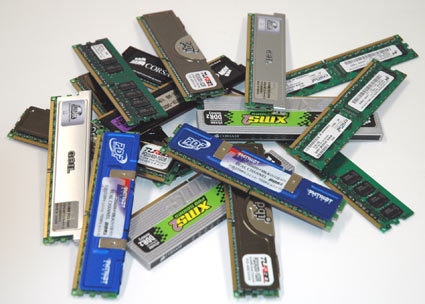Tight Timings vs High Clock Frequencies
Introduction
If you are reading this article, there is a good chance that at some point, you have found yourself wondering about what you should do to maximize memory performance. Should you go for memory that runs with tight timings and average frequency, or for relaxed timings at high clock frequencies? In fact, you might ask whether the whole timings vs. clock speed discussion affects performance at all?
From a memory requirement standpoint, a pair of 1 GB memory modules is undoubtedly the best choice for a high end computer today. The main purpose of a comfortable RAM size is to offer sufficient memory for your applications, and to prevent Windows from swapping application data to the swap file on your (relatively slow) hard drive. In this context, neither the memory type nor the speed is as important as simply having enough. The only thing we recommend in terms of memory size is to use two modules, to allow you to run in high performance dual channel mode.
However, the current 1 GB DDR products don't support the tight timings or high clock frequencies of 512 MB DIMMs, so your choices between timings and clock frequencies are somewhat limited. Looking at DDR2 memory, which is going to dominate by the end of this year, the situation gets even worse. Here, memory timings are further relaxed for the sake of bumping up memory clock speed.
Even if you don't understand what memory timing parameters actually stand for, it is still easy to understand that smaller cycle times represent quicker operation. For example, DDR memory runs at speeds between CL2-2-2-5 and CL3-4-4-7 clock cycle settings, while DDR2 varies from CL3-2-2-8 to CL5-5-5-15. The latter effectively doubles the latencies when compared to quick DDR1 timings, which is why DDR2 memory must run at considerably faster clock speeds to outperform DDR1.
We picked an AMD Athlon 64 system for our detailed memory performance analysis, because the memory controller is part of the processor and is thus sensitive to memory speed and timing changes. Our intention is to show the performance differences when changing the following:
- CPU clock speed: from 1450 MHz to 2610 MHz;
- Memory clock speed: from 200 to 290 MHz; and
- Memory timings: from CL2.0-2-2-5 to CL3.0-4-4-7
We'll also examine performance scaling at different clock speeds and timings.
Get Tom's Hardware's best news and in-depth reviews, straight to your inbox.
-
jona1 Excellent article. I was looking for a good explanation of memory timings. Thank you (I am from Uruguay, sorry for my bad English :) )Reply -
Good Article I guess. I've been wondering that exact question now that i got 2x1GB of Patriots PC2-8500 Viper Series from NVISION08. The timings are 5-5-5-15 2T at 1066MHz. When i try to lower it 1T it's not reliable. Anyways, thanks tomshardware for another good article, I hope there is a sequel to this, specifically DDR2 or 3 memory.Reply
-
spellbinder2050 ReplyAs most of you are probably aware, the MHz clock speed of the Athlon 64 and Opteron is the product of the HyperTransport speed (HTT) times the multiplier of the CPU.
Correct me if I'm wrong, but shouldn't this be written as, "the MHz clock speed of the Athlon 64 and Opteron is the product of the HyperTransport speed (HTT) and the multiplier of the CPU."
